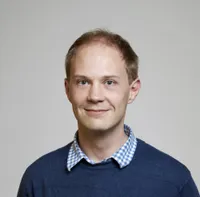Alex Robertson
Research overview
My group uses transmission electron microscopy (TEM) to understand the dynamic structural and chemical changes that nano and energy materials undergo while being operated in conditions relevant to applications. We are interested in two-dimensional materials for 'beyond Moore" electronics, new material chemistries for better rechargeable batteries, and understanding nanostructuring in new heterogeneous catalysts. I am part of the Microscopy Group in the Physics Department, and we use Warwick's Electron Microscopy Research Technology Platform among other facilities to do research at the nanoscale.
--

PhD Studentships!
For October 2024 start
Email me if you are interested in a PhD in any of these areas below or apply to my advertised posts!
--
2D MATERIALS
Two-dimensional materials are an exciting class of nano-material with potential application in unlocking 'beyond Moore' electronics - that is, the devices we will need once silicon hits its scaling limits. Understanding how their atomic structure relates to their properties is essential, as even single atom defects can have a pronounced effect. We use TEM to understand these relationships.
BATTERIES
Better rechargeable batteries are a 'grand challenge' in materials science, as they are fundamental for decarbonisation. Yet the processes at the heart of a battery are inherently complex, with many interlinked factors that need to be untangled if we wish to understand how to design better materials. We use advanced TEM techniques to image these processes as they occur at the nanoscale to diagnose these processes.
CATALYSTS
Catalysts are indispensable for our modern society, allowing us to create the civilization-sustaining chemicals, from fertilisers to medicines to fuel, that keep us fed and healthy. Designing new catalysts will be central for unlocking new green industries, including hydrogen energy, CO2 conversion, biofuels, and more. Many catalysts rely on nanostructures, or even single atoms, on their surface to provide activity. We identify these sites to inform better catalyst design.
Teaching and administration
Currently I am the postgraduate admissions tutorLink opens in a new window, which means I help handle the Department's recruitment of PhDs and research MSc students alongside Rosalind Johnstone (postgraduate programmes officer - ). If you are interested in applying to study Physics at Warwick and have any questions then please contact me.
I take tutorials for students who study the Physics undergraduate course (F300 and F303) and supervise final year experimental research projects. I currently lecture the fourth year MPhys course on Superconductivity in the Condensed Matter Physics II module (PX446).
I am also fortunate enough to currently supervise/teach three excellent PhD students - Robert Wells, Zixuan Li, and Yi Yuan - and have also previously supervised Dr Chen Gong and Dr Shengda Pu.
My background
Currently I'm an assistant professor in the Department of Physics here at Warwick, and have been since 2021. I am also a current holder of a Royal Society University Research Fellowship (URF), which started in 2018. Prior to moving to Warwick I had based my Fellowship at the Materials Department at Oxford University. During 2017 I worked as a post-doc at the Pacific Northwest National Laboratory in the USA. Prior to that, I was a post-doc at Oxford from 2013 to 2016, partly funded by an EPSRC doctoral prize award, supervised by Prof Jamie Warner, whom I also studied under for my PhD in Materials Science at Oxford. I studied for my undergraduate MPhys degree at Durham University.
Some recent papers
You can have a look at some of our recent research highlights at the Research Highlights page, or by following the Google Scholar link on the right panel. Here are some links through to some recent highlight papers.
- Trapped O2 and the origin of voltage fade in layered Li-rich cathodes in Nature Materials, 2024.
- Diagnosing the Electrostatic Shielding Mechanism for Dendrite Suppression in Aqueous Zinc Batteries in Advanced Materials, 2023.
- The role of an elastic interphase in suppressing gas evolution and promoting uniform electroplating in sodium metal anodesLink opens in a new window in Energy & Environmental Science, 2023.
- Decoupling, quantifying, and restoring aging-induced Zn-anode losses in rechargeable aqueous zinc batteriesLink opens in a new window in Joule, 2023.
- Electrolyte engineering strategies for regulation of the Zn metal anode in aqueous Zn-ion batteriesLink opens in a new window a review in Battery Energy, 2023.
- Achieving ultrahigh‐rate planar and dendrite‐free zinc electroplating for aqueous zinc battery anodesLink opens in a new window in Advanced Materials, 2022.
- Revealing the Role of Fluoride-Rich Battery Electrode Interphases by Operando Transmission Electron MicroscopyLink opens in a new window in Advanced Energy Materials, 2021.
- Preparation and application of 0D-2D nanomaterial hybrid heterostructures for energy applicationsLink opens in a new window a review in Materials Today Advances, 2021, written with my then postdoc, Dr Sapna SinhaLink opens in a new window.
- Direct observation and catalytic role of mediator atom in 2D materialsLink opens in a new window in Science Advances, 2020.
- Liquid cell transmission electron microscopy and its applicationsLink opens in a new window in Royal Society Open Science, 2020.
- Atomic Structure and Dynamics of Epitaxial Platinum Bilayers on GrapheneLink opens in a new window in ACS Nano, 2019.
- Addressing the isomer cataloguing problem for nanopores in two-dimensional materialsLink opens in a new window in Nature Materials, 2019.

Dr Alex W Robertson
Assistant Professor
Microscopy Group
Google Scholar: Publication listLink opens in a new window
Contact Details
Links
Funders



Past funders




